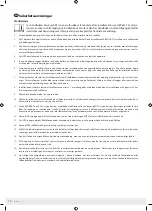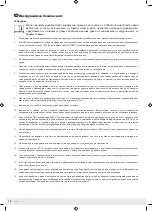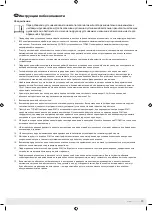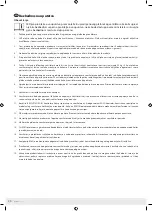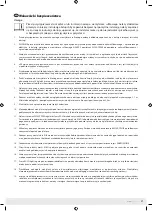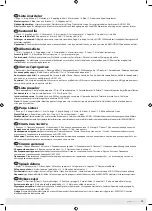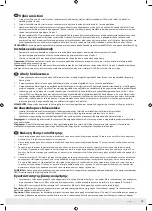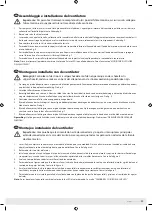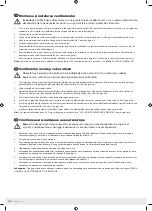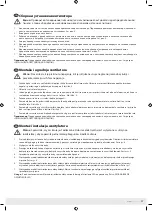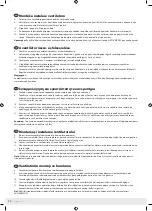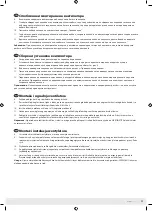
26
BONDI
Ceiling Fan
Position auswählen
1.
Der Deckenventilator muss so installiert werden, dass die Flügel einen Mindestabstand von 300 mm von der Flügelspitze zu den
nächstgelegenen Objekten oder Wänden aufweisen.
2.
Der Deckenventilator muss so installiert werden, dass sich die Flügel mindestens 2,1 m über dem Boden befinden.
3.
Der Befestigungspunkt für Ihren Deckenventilator muss solide, unbeschädigt und in der Lage sein, eine Last von 35 kg oder das 4-fache des
Gewichtes des Ventilators plus der Befestigungsart zu tragen, je nachdem, welches höher ist. Wenn der Standort keinen stabilen Montagepunkt
hat, müssen Sie eine Holzstütze zwischen zwei Deckenbalken installieren. Siehe Abb. 2.
4.
Viele EGLO-Ventilatoren sind für den Innenbereich konzipiert, können aber auch an entsprechend abgedeckten Außenbereichen installiert
werden, an denen der Ventilator vollständig abgedeckt ist und wo mindestens 2 Wände vorhanden sind. Der Ventilator ist nicht wasserfest. Bei
der Installation im Außenbereich muss der Deckenventilator an einem vor Wasser, Wind, Staub und Salz geschützten Ort installiert werden. Das
Einwirken dieser Elemente auf den Ventilator führt zum Erlöschen der Garantie. In einigen tropischen Gebieten Australiens wird empfohlen,
den Abstand vom Ventilator bis zum Rand des Daches zu vergrößern.
HINWEIS: Das Bild dient nur zur Darstellung und stellt nicht die tatsächliche Halterung dar. Der Befestigungspunkt MUSS eine Tragkraft von 45 kg aufweisen.
Montage der Aufhängehalterung
1.
Montieren Sie die Aufhängehalterung mit den mitgelieferten langen Schrauben am Deckenbalken oder an der Holzstütze.
Führen Sie die Schrauben durch die Langlöcher in der Hängevorrichtung und befestigen Sie sie an der Decke. Siehe Abb. 3.
2.
Achten Sie darauf, dass mindestens 30 mm der Schraube in den Deckenbalken oder die Holzstütze eingeschraubt sind.
Hinweis:
Die mitgelieferten Befestigungsschrauben sind für die Verwendung mit Holzdeckenbalken vorgesehen, für alle anderen Materialien müssen
die entsprechenden Befestigungsschrauben gekauft werden.
Hinweis: Die Aufhängehalterung Ihres Ventilators ermöglicht die Montage an abgewinkelten/abgeschrägten Decken bis zu einer Neigung von 15 Grad. Bei
der Montage an Winkel-/Schrägdecken ist der Kanal der Hängevorrichtung so zu montieren, dass die Öffnung nach OBEN in Richtung Deckenneigung zeigt.
Selecting a location
1.
The ceiling fan must be installed in a location so that the blades are a minimum 300mm spacing from the tip of the blade, to the
nearest objects or walls.
2.
The ceiling fan must be installed in a location so that the blades are a minimum 2.1m above the floor.
3.
The fixing point for your ceiling fan must be of sound construction, undamaged, and capable of supporting a load of 35Kg, or 4 times
the weight of the fan plus the method of attachment, whichever is greater. If the location does not have a solid mounting point, you
will need to install a timber support between two ceiling joists. Refer to Fig. 2.
4.
Many EGLO fans are designed for indoor use, though they can also be installed in appropriately covered outdoor locations where the
fan is fully undercover with a minimum of 2 walls. This fan is not waterproof. When installed in outdoor areas, the ceiling fan must be
installed in a location protected from water, wind, dust, and salt. Exposure to these elements will void the warranty. In some more
tropical areas of Australia, it is suggested you increase the distance from the fan to the edge of the roof.
Note: Image is for representation only, and does not represent the actual bracket. Fixing point MUST be able to support a 45 kg load.
Installing the hanging bracket
1.
Install the hanging bracket to the ceiling joist or timber support with the long installation screws provided. Pass the screws through the
slotted holes in the hanging bracket and secure to the ceiling. Refer Fig. 3.
2.
Ensure that at least 30mm of the screw is threaded into the ceiling joist or timber support.
Note: The fixing screws included are designed for use with timber ceiling joists, for all other materials, the appropriate fixing screws will need to be purchased.
Note: Your fans hanging bracket allows for mounting on angled/sloped ceilings up to a 15-degree pitch. When mounted on angled/sloped
ceilings, the hanger bracket muct be installed so that the opening is facing UP the direction of ceiling pitch.
Choix du lieu d’installation
1.
Le ventilateur de plafond doit être installé dans un endroit permettant un écart de 300 mm entre l’extrémité des pales et l’objet ou le
mur le plus proche.
2.
Le ventilateur de plafond doit être installé dans un endroit permettant une distance d’au moins 2,1 m par rapport au sol.
3.
Le point de fixation de votre ventilateur de plafond doit être solide, en parfait état et capable de supporter le poids le plus élevé entre
une charge de 35 kg ou l’équivalent de 4 fois le poids du ventilateur ainsi que le mode de fixation. Si le lieu d’installation ne dispose pas
d’un point de montage solide, vous devrez installer un support en bois entre les deux solives du plafond. Voir Figure 2.
4.
De nombreux ventilateurs EGLO sont conçus pour être utilisés en intérieur bien qu’ils puissent également être installés dans des lieux
adéquatement couverts en extérieur à condition d’être entièrement abrités et entourés par 2 murs au moins. Ce ventilateur n’est
pas étanche. En cas d’utilisation en extérieur, le ventilateur de plafond doit être installé dans un endroit protégé de l’eau, du vent, de
la poussière et du sel. Toute exposition à ces éléments aura pour effet l’annulation de la garantie. Dans certaines régions tropicales
d’Australie, il est recommandé d’augmenter la distance séparant le ventilateur du bord de la toiture.
Note: Remarque : Les images sont fournies uniquement à titre indicatif et ne représentent pas le support réel. Le point de fixation DOIT être
capable de supporter une charge de 45 kg.
Installation du support de suspension
1. Installez le support de suspension sur la solive du plafond ou le support en bois avec les longues vis d’installation fournies.
Poussez les vis à travers les fentes du support de suspension et fixez-les au plafond. Voir Figure 3.
2. Assurez-vous qu’au moins 30mm de vis est inséré dans la solive du plafond ou le support en bois.
Remarque : Les vis de fixation incluses sont conçues pour être utilisées avec solives de plafond en bois. Pour tous les autres
matériaux, vous devrez acheter les vis de fixation adaptées.
Remarque : Le support de suspension de votre ventilateur permet de monter ce dernier sur un plafond incliné d’une pente de 15 degrés
maximum. En cas de montage sur un plafond incliné, le support de suspension doit être installé de manière à ce que l’ouverture soit orientée
vers le HAUT par rapport à la direction de l’inclinaison du plafond.
Fig.
2
Fig.
3

